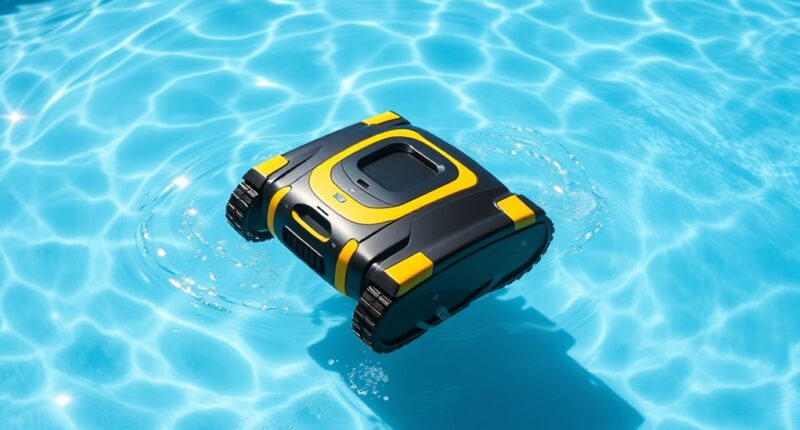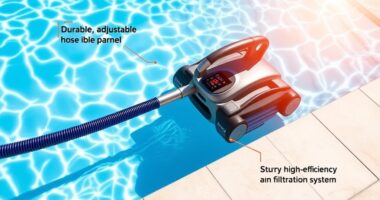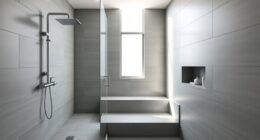Automatic pool cleaners are great at picking up surface debris, dirt, and leaves, but they can’t fully eliminate stubborn algae or clear cloudy water on their own. They work best when combined with proper chemical treatments and good filtration. Thick algae patches or cloudy water typically require manual brushing, shock treatments, or algaecides. To keep your pool sparkling, understanding how to use these tools effectively is key—continue on to discover more tips and tricks.
Key Takeaways
- Automatic pool cleaners effectively remove dirt and debris but struggle with stubborn or thick algae patches.
- They depend on proper chemical balance and filtration to maintain water clarity and prevent algae growth.
- Cloudy water often requires chemical treatments and manual cleaning, as cleaners alone cannot fully clarify the pool.
- Automatic cleaners may miss algae in uneven or heavily contaminated areas, necessitating manual brushing or chemical use.
- Combining automatic cleaning with chemical treatments and manual methods ensures optimal pool cleanliness and clarity.
How Automatic Pool Cleaners Work
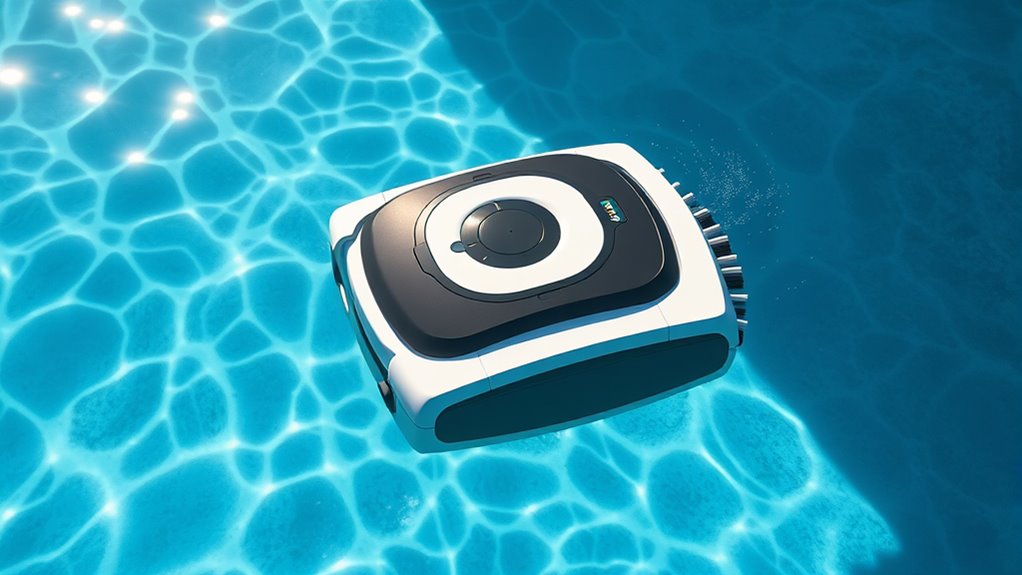
Automatic pool cleaners work by moving around your pool to remove dirt, debris, and algae without much effort from you. They operate using various power sources, including solar power, which makes them an eco-friendly choice. During pool installation, you can opt for models that harness solar energy, reducing electricity costs. These cleaners follow programmed paths or use sensors to navigate the pool’s surface, ensuring thorough coverage. Some models are robotic, with built-in filters to trap debris, while others are suction or pressure-side cleaners connected to your pool’s filtration system. Their movement and cleaning actions are designed to efficiently cover every inch of your pool, making routine maintenance easier. With proper pool installation, integrating an automatic cleaner that uses solar power can offer long-term savings and convenience. Additionally, selecting the right model can help you manage algae and cloudy pools more effectively by targeting common contaminants, and many advanced models incorporate features to address water clarity issues. These devices are often designed with energy efficiency in mind, helping to reduce overall operating costs and environmental impact.
Effectiveness Against Debris and Dirt
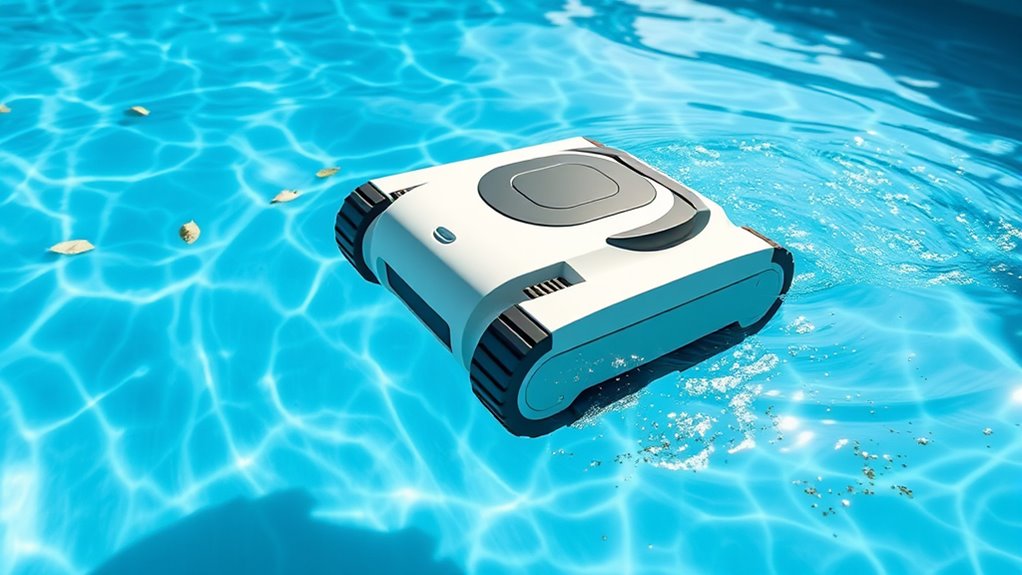
When it comes to removing debris and dirt from your pool, automatic cleaners are highly effective tools that can considerably reduce your cleaning efforts. They efficiently pick up leaves, dirt, and other particles, keeping your pool tidy. However, their effectiveness depends on maintaining proper water chemical balance, as imbalanced water can hinder cleaning performance. Well-balanced chemicals ensure debris loosens and moves freely, allowing the cleaner to do its job better. Additionally, a clean pool promotes pool safety by preventing algae growth and bacteria buildup. Regularly checking and adjusting your water chemistry enhances the cleaner’s ability to remove dirt and debris, ensuring your pool stays clear and safe for swimming. Proper water chemistry is essential for optimal cleaner performance and long-term pool health. For instance, algae prevention can be significantly improved by maintaining appropriate chemical levels, further aiding automatic cleaner efficiency. Automatic cleaners are a valuable aid in maintaining cleanliness with less effort on your part. Maintaining a balanced chemical level also helps extend the lifespan of your cleaning equipment by preventing buildup and corrosion. Ensuring the right water circulation can further improve debris removal and prevent stagnation in your pool.
Limitations in Algae Removal
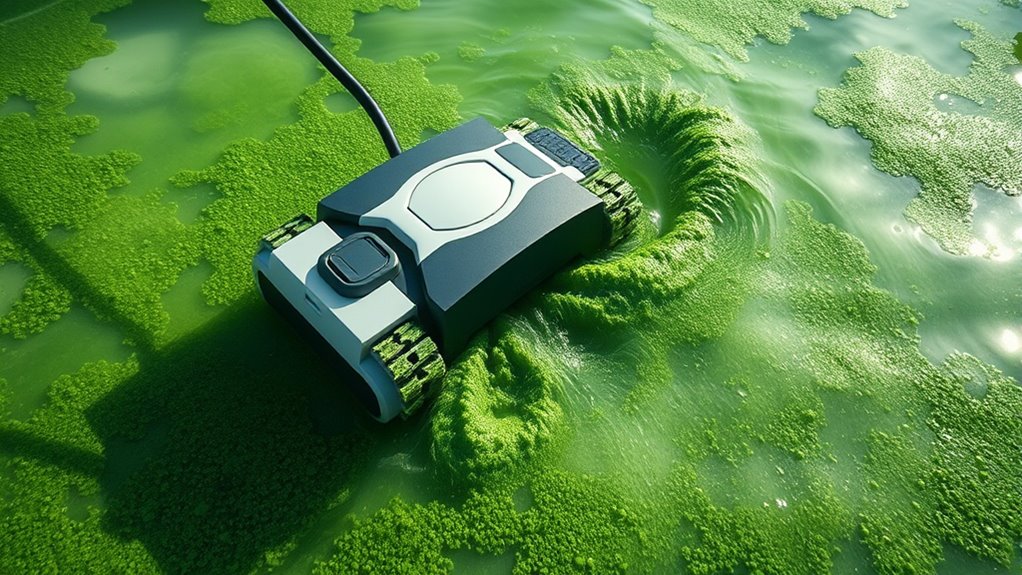
Automatic pool cleaners may not cover every inch of algae, leaving some spots untreated. They also struggle with thick or stubborn growth, which can require manual intervention. Recognizing these limitations helps you set realistic expectations for algae removal. Additionally, understanding the importance of proper preventive measures can significantly reduce algae growth and ease cleanup efforts. Regular maintenance and water chemistry management are crucial components in preventing algae from taking hold in your pool.
Incomplete Algae Coverage
Have you noticed that some algae patches stubbornly remain despite running your pool cleaner? This is often due to incomplete algae coverage, where the cleaner struggles with algae patchiness. Algae spread unevenly, making it difficult for automatic cleaners to detect and remove all affected areas effectively. Additionally, the anti-algae ingredients in some pool treatments can influence how well cleaners perform on affected surfaces. Sometimes, the surface texture of the pool affects how easily algae can be removed by automatic cleaners. Moreover, algae behavior can vary depending on environmental factors, complicating automatic removal efforts. Recognizing the limitations of automatic cleaners can help pool owners develop more effective maintenance strategies.
| Algae Patchiness | Algae Spread |
|---|---|
| Difficult to predict | Varies by conditions |
| Hinders thorough cleaning | Leads to uneven algae removal |
| Often missed by automatic cleaners | Causes recurring patches |
Because of this, some algae remain hidden or only partially removed, allowing the problem to persist. Automatic cleaners can struggle to address these inconsistencies, meaning manual intervention may be necessary to fully eliminate algae. Understanding pool maintenance techniques can help improve overall cleaning effectiveness and prevent future algae growth.
Struggles With Thick Growth
Thick algae growth poses a significant challenge for automatic pool cleaners because their brushes and suction power often can’t fully penetrate dense, slimy layers. Difficult algae, especially when it has turned into stubborn stains, can cling tightly to the pool surfaces. These cleaners struggle to remove such stubborn buildup because their mechanisms aren’t designed to handle heavily entrenched algae. Additionally, some advanced cleaning systems incorporate digital platforms to optimize performance, but even these may fall short against thick algae layers. As a result, thick growth can remain uncleaned, leaving your pool looking cloudy and unsightly. You might find yourself needing to intervene manually or use chemical treatments to break down the stubborn stains before the cleaner can do its job effectively. Understanding types of algae present can help in choosing the right treatment approach and tailor your maintenance routine accordingly. Recognizing algae growth patterns can also guide preventive measures to keep pools clearer. Regular pool maintenance practices are essential to prevent such issues from recurring. Incorporating preventive chemical treatments can significantly reduce the likelihood of thick algae buildup, ensuring your pool stays cleaner longer. Ultimately, while automatic cleaners excel at surface debris, thick algae layers often require additional effort to fully eliminate.
Can They Handle Cloudy Water?
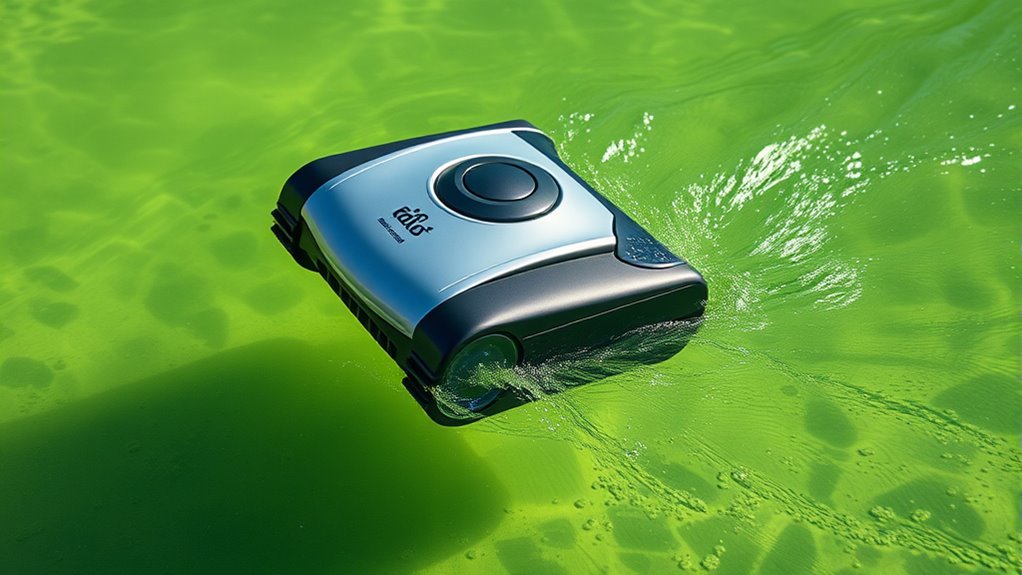
Wondering if automatic pool cleaners can effectively clear up cloudy water? They can help, but only if the water is properly balanced and algae prevention measures are in place. Cloudiness often results from unfiltered debris or imbalance, not just dirt. Regularly maintaining chemical balance reduces particles that cause cloudiness, while algae prevention prevents slimy buildup. While cleaners scrub surfaces, they don’t replace filtration or chemical treatment. Here’s a quick comparison:
| Feature | Automatic Cleaner | Filtration System | Chemical Balance |
|---|---|---|---|
| Removes debris | Yes | Yes | Indirect support |
| Clears cloudiness | Partially | Essential | Critical |
| Handles algae prevention | Limited | No | Yes |
Using these tools together ensures your pool stays clear and inviting. Proper chemical balance is essential to prevent algae growth and maintain water clarity. Additionally, ensuring your filtration system operates effectively is crucial for consistent water clarity.
The Role of Pool Chemicals and Filtration
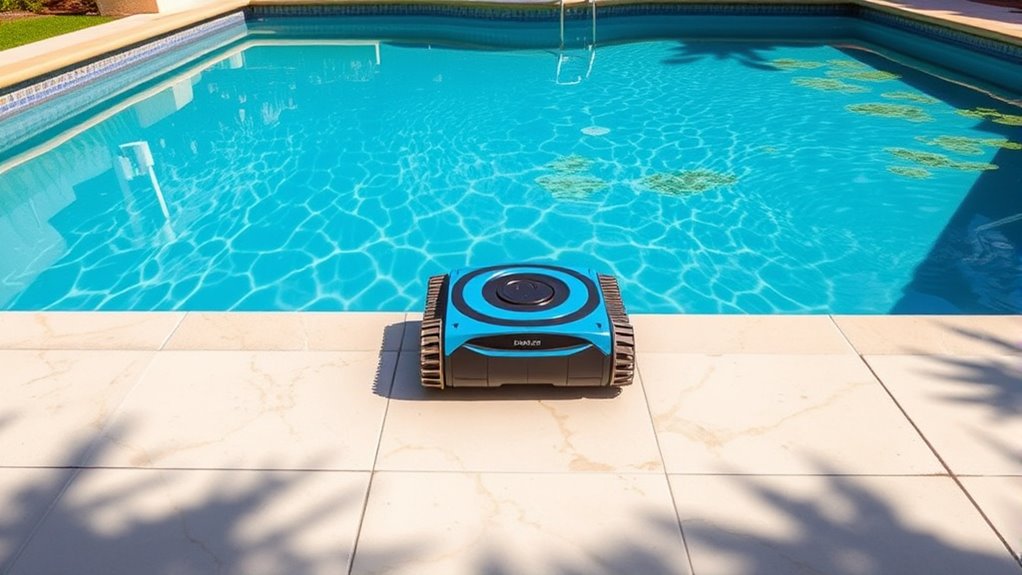
While automatic pool cleaners help remove debris and partially address cloudy water, they can’t do the full job without proper chemical balance and a good filtration system. Maintaining the right pool chemical balance is essential to prevent algae growth and keep water clear. You need to regularly test and adjust pH, chlorine levels, and other chemicals to ensure the water stays sanitized and balanced. Your filtration system plays a critical role by trapping dirt, algae spores, and other particles that cleaners might miss. A clean, well-maintained filter improves water clarity and reduces strain on your automatic cleaner. Together, proper chemical treatment and an efficient filtration system work in tandem to keep your pool sparkling clean, making your automatic cleaner more effective and your swimming experience more enjoyable.
When to Use Additional Algae Treatments
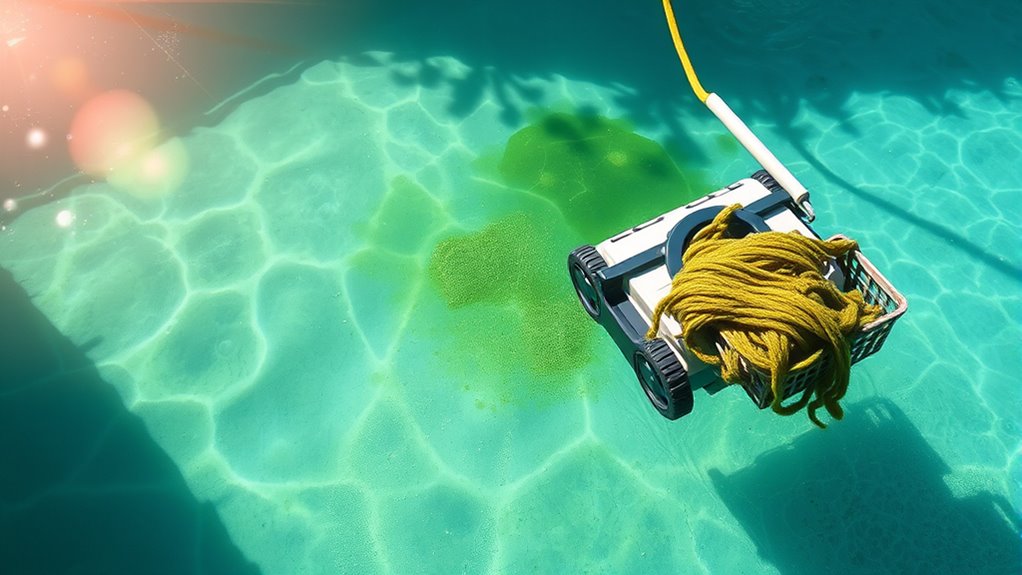
You’ll want to take into account additional algae treatments if you notice spots or cloudy areas that automatic cleaners can’t fully remove. Sometimes, even with regular cleaning, algae can persist or reappear, signaling the need for stronger chemicals. Knowing when to add these treatments ensures your pool stays clear and algae-free efficiently. Additionally, understanding effective chemical application can help homeowners stay vigilant about maintaining a healthy and clean environment, free from unwanted issues. Recognizing the importance of love and relationships can also foster a more attentive and caring approach to pool maintenance, as it often involves nurturing and protecting your shared space.
Spotting Algae Growth
Algae growth often signals that your pool needs more than just regular filtration and cleaning. Spotting algae growth early is key, so look for algae spot detection around the pool’s surfaces, especially in shaded or hard-to-reach areas. Water discoloration issues, like green, cloudy, or murky water, also indicate algae presence. If you notice these signs, it’s time to step up your treatment. Automatic pool cleaners can help keep debris at bay, but they won’t eliminate algae on their own. You’ll need to manually brush affected areas and add algaecide or shock treatment to kill algae spores. Regular monitoring and prompt action can prevent algae from spreading and keep your pool clear and inviting.
Effectiveness of Automatic Cleaners
Automatic pool cleaners are effective at removing surface debris and keeping your pool tidy, but they often can’t fully eliminate algae or prevent its spread. If algae begins to form, especially near the pool decking or around areas heated by solar heating, additional treatments are necessary. These cleaners excel at maintaining cleanliness but lack the chemical action needed to combat algae growth thoroughly. When algae persists, running your automatic cleaner isn’t enough; you’ll need to manually brush affected areas and add algaecides. Regular maintenance around solar heating units and pool decking can also reduce algae buildup. While automatic cleaners help with surface dirt, controlling algae requires targeted chemical treatments and proper circulation. Relying solely on automatic cleaners won’t keep your pool clear in algae-prone conditions.
When to Add Chemicals
Knowing when to add chemicals is essential for maintaining a clear and healthy pool, especially when automatic cleaners alone don’t keep algae at bay. If you notice persistent algae or cloudy water, it’s time to test your chemical balance. Proper pH and chlorine levels are crucial to prevent algae growth. Using a pool heater can help improve chemical effectiveness, but it’s vital to adjust chemicals accordingly. When algae persists, you may need to add algaecide or shock treatments. Regularly check your water’s chemical levels and adjust as needed. This guarantees the sanitizer works efficiently, supporting your automatic cleaner and preventing algae from taking over. Maintaining proper chemical balance is key to a sparkling, algae-free pool.
Enhancing Pool Cleaning With Manual Methods
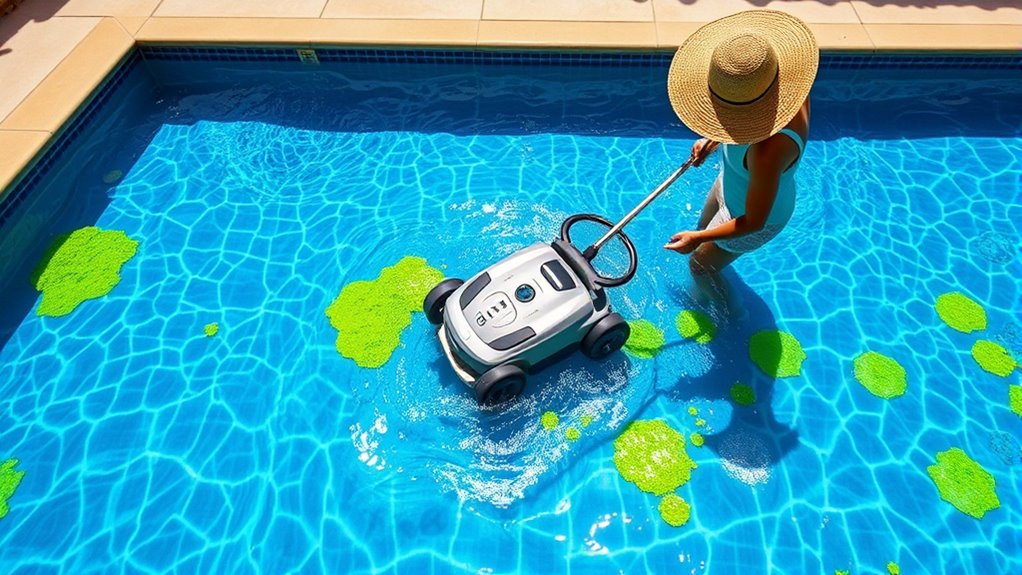
While automatic pool cleaners are effective, manual methods can considerably enhance your pool’s cleanliness, especially when addressing stubborn algae or cloudy water. Start by manually brushing the pool walls and floor to loosen algae and debris, making it easier for the cleaner to remove. Use a pool net to remove surface debris and settle particles. Adjust your pool heater to ensure proper circulation and temperature, aiding chemical distribution. Proper chemical balancing is essential; test and correct pH, alkalinity, and sanitizer levels to prevent algae growth and cloudiness. Running the pump longer during manual cleaning helps circulate chemicals thoroughly. These manual steps, combined with your automatic cleaner, ensure your pool stays clearer, healthier, and more inviting.
Tips for Maintaining a Clear and Healthy Pool
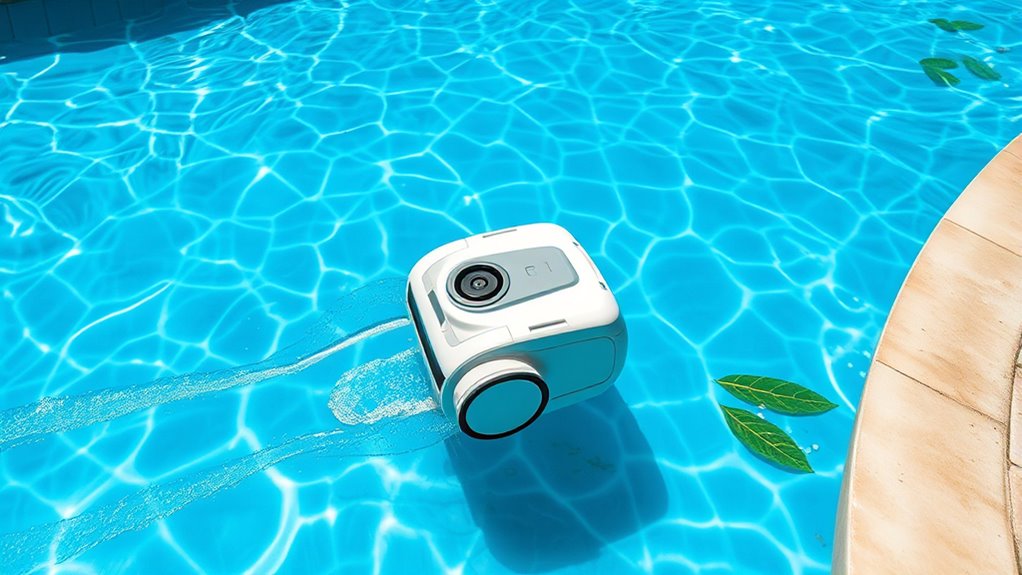
Maintaining a clear and healthy pool requires consistent effort and attention to detail. Regularly check your water chemistry, balancing pH levels and chlorine to prevent algae growth and cloudiness. Use a pool heater wisely, ensuring the water temperature stays within the ideal range; warmer water can promote algae, so adjust your heater accordingly. Keep your automatic pool cleaner running efficiently to remove debris and reduce contaminants. Skim the surface daily and vacuum the bottom weekly. Run your filter long enough each day to circulate and filter the water effectively. Proper maintenance of your pool’s equipment, including the heater, helps sustain clear, inviting water. Staying proactive with these tips ensures your pool remains clean, healthy, and ready for swimming.
Frequently Asked Questions
Can Automatic Pool Cleaners Prevent Algae Growth in the First Place?
Automatic pool cleaners are great for maintaining your pool, but they can’t prevent algae growth on their own. For effective algae prevention, you need to focus on proper chemical balance and regular skimming. Keep your pH and chlorine levels in check, and run your cleaner frequently to remove debris. This combined approach helps prevent algae buildup and keeps your pool clear, healthy, and inviting all season long.
Are Robotic Pool Cleaners More Effective Than Suction-Side Models?
Think of robotic pool cleaners as the sleek sports cars of pool maintenance—they’re built for superior performance. You might notice robotic superiority in their ability to reach tricky spots and scrub thoroughly, unlike suction-side models which rely on suction efficiency. For example, a friend switched to a robotic cleaner and saw her pool stay cleaner longer. Overall, robotic models typically offer more advanced features, making them more effective for exhaustive cleaning.
How Often Should I Run My Automatic Cleaner During Algae Outbreaks?
During algae outbreaks, you should run your automatic cleaner daily to maintain proper pool chemistry and guarantee effective debris removal. This frequent cleaning helps break down algae spores and reduces cloudiness. Make sure to balance your chemicals before running the cleaner, and consider using algaecide treatments. Consistent operation keeps your pool clear, preventing algae from spreading and making maintenance easier overall.
Do Automatic Cleaners Require Special Maintenance for Algae-Prone Pools?
If your pool is algae-prone, you’ll want to perform regular maintenance on your automatic cleaner. This includes inspecting and cleaning the filter more often to prevent clogs, and using appropriate chemical treatments to keep algae at bay. You might also need to occasionally scrub surfaces manually. Proper filter maintenance and chemical balance are key to ensuring your cleaner works effectively and your pool stays clear.
Can Automatic Cleaners Remove Algae From Pool Walls and Tiles Efficiently?
Imagine your pool’s walls covered in algae, making cleaning seem intimidating. Automatic pool cleaners can handle algae removal and wall cleaning effectively, especially models with brushes and scrubbing features. They reach into corners and scrub algae off tiles, saving you time. However, for heavy algae buildup, you might need to pre-treat the pool. Still, automatic cleaners are a helpful tool for maintaining clear, healthy walls and tiles.
Conclusion
While automatic pool cleaners are your trusty ships sailing through debris and dirt, they’re not magic wands for algae and cloudiness. Think of them as the first line of defense, but you’ll need to rally your pool chemicals and manual tools to truly clear the waters. With a little teamwork, your pool can shine like a gemstone beneath the sun, inviting you to plunge into crystal-clear waters that sparkle with health and freshness.
